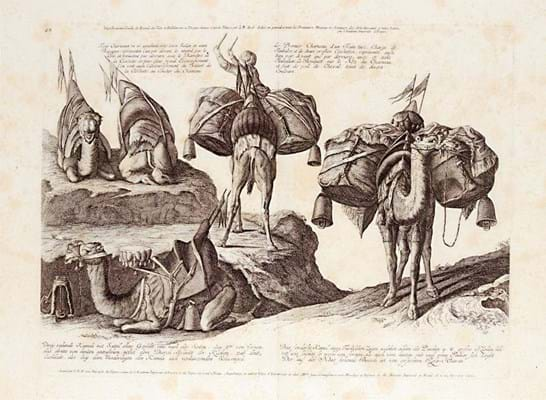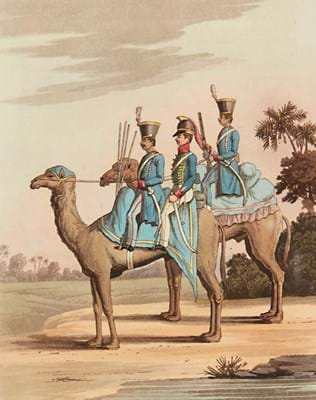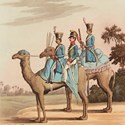The camel has a single hump;
The dromedary two;
Or else the other way around.
I’m never sure. Are you?
Both lots were part of a Sotheby’s (25/20/12.9% buyer’s premium) sale of May 15. Shown above is one of 41 engraved plates (on 31 double-page sheets) that, together with a plan of Constantinople, illustrate Philipe François, Baron de Gudenus’ Collection des Prospects et Habillements en Turquies.
A folio work printed at the Imperial Academy of Augsburg c.1742, it sold at £48,000.
Ten of those plates form a panorama of the city and 15 focus on local costumes, but this double-page plate of camels is definitely among the more striking images. The sheets showed occasional tears, repairs, creases and a certain amount of spotting, but it is a rare work.
The other camel plate (also above) is an old favourite. Depicting men and mounts of the Bengal Army’s ‘Rocket Corps and Dromedary Corps’, it is one of nine hand-coloured aquatints, along with maps, plans, etc, found in an 1819 first of George Fitzclarence’s Journal of a Route across India, through Egypt to England.
The author, 1st Earl of Munster, was an illegitimate son of William IV, who, having served in the East India Company’s successful campaigns against the Mahratta, or Maratha, Confederacy in India, had been entrusted with taking back to England dispatches relating to the peace treaty that had followed. In a period binding, rebacked to preserve the original spine, this copy of his overland travel journal, sold at £1100, was not perfect.
However, in 2014, an example in Franklin Brooke- Hitching’s great travel library made £5750 in the same rooms. That one was inscribed by its author “with respectful duty” to his uncle, Ernest Augustus, the Duke of Cumberland and also King of Hanover.


















